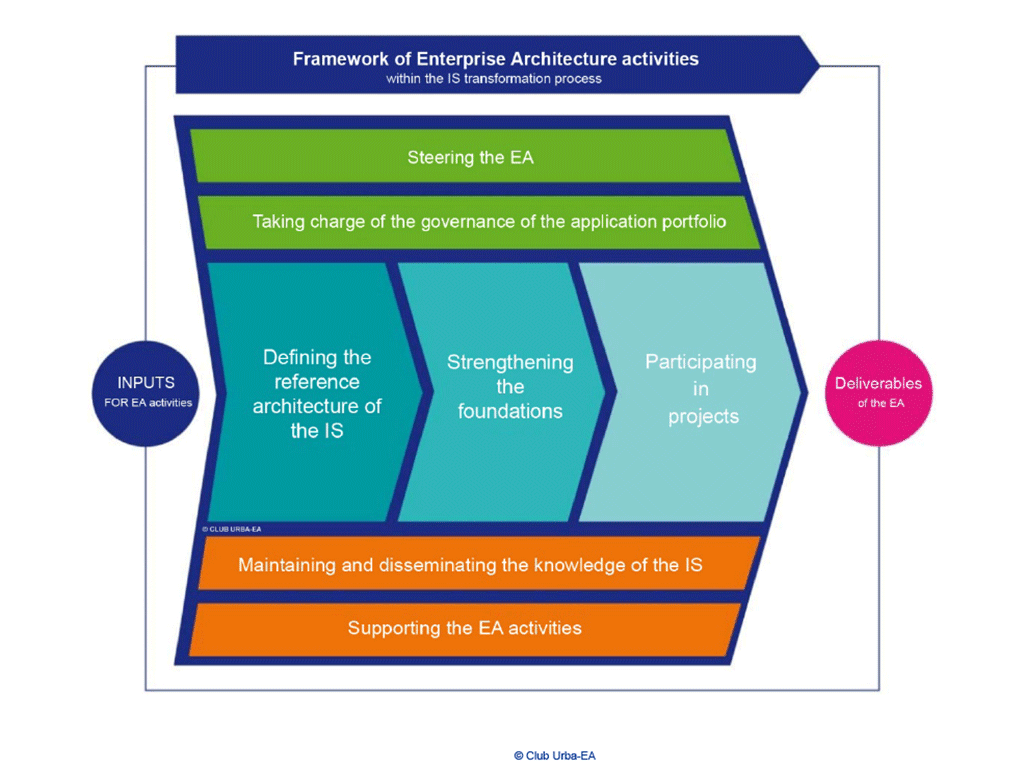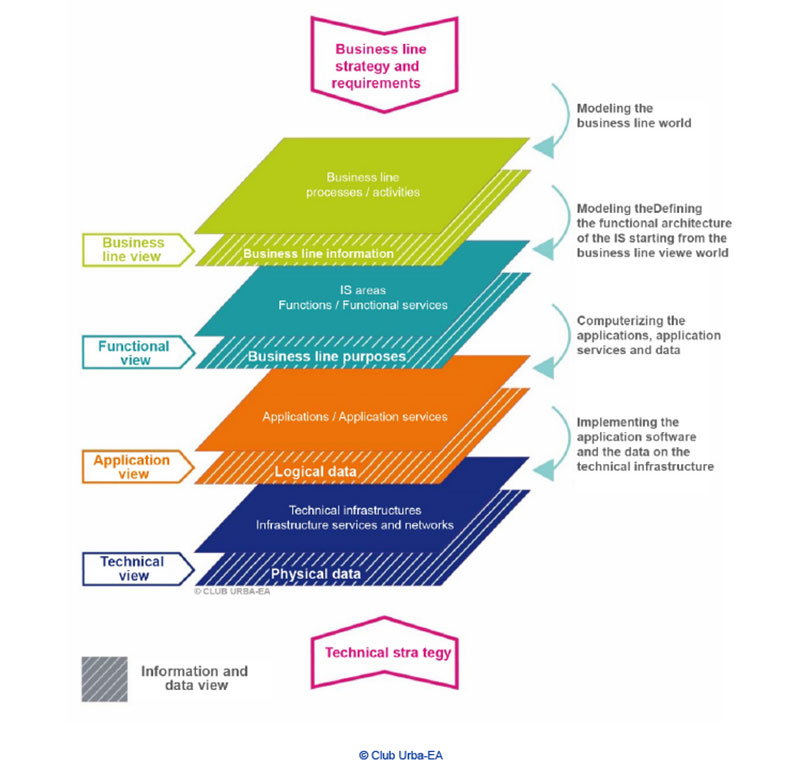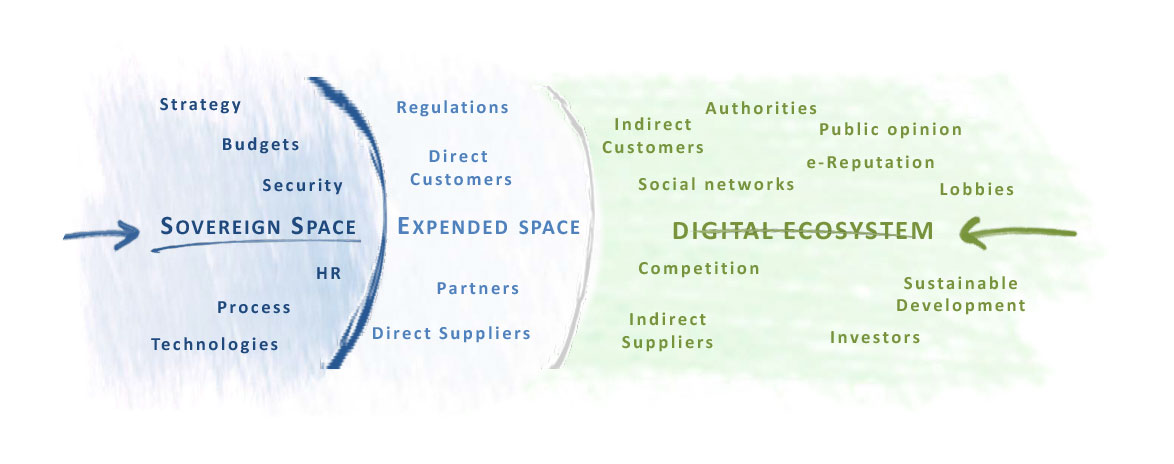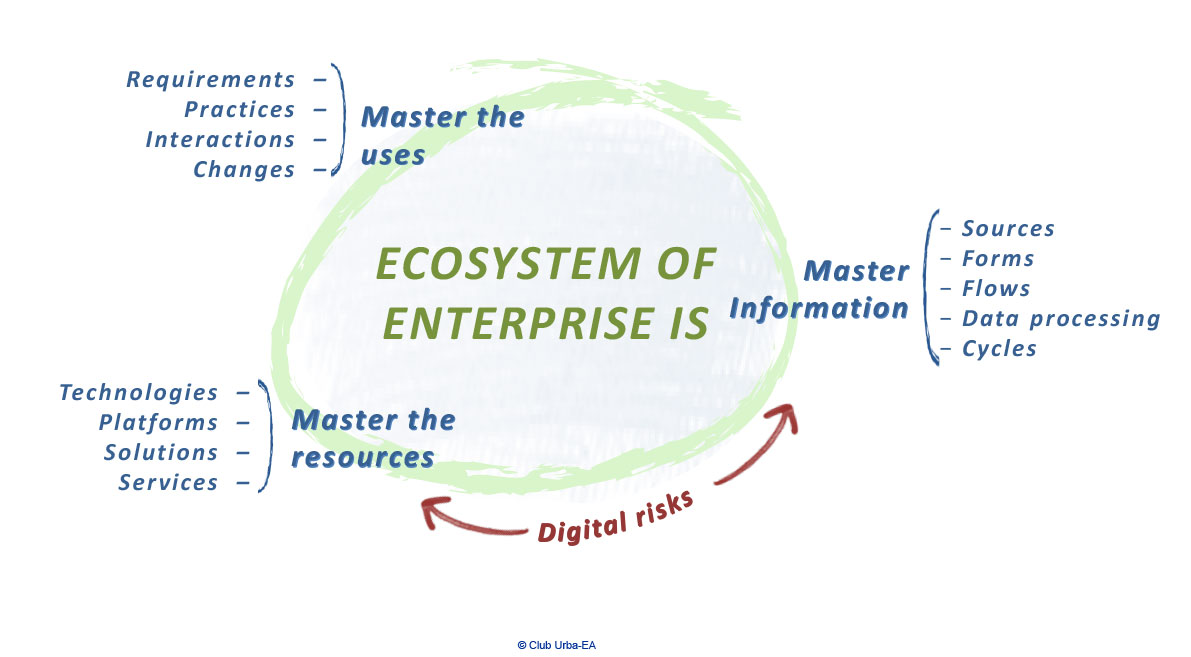
What is the Enterprise Architecture ?
The Enterprise Architecture (EA) is a major lever for defining these IS transformations and to steer them.
The diversity and complexity of transformations (including digital but not limited to it) conducted in parallel by public organizations enterprises reinforce the contribution of the EA.
Capitalizing on the experience of its members, the Urba -EA Club has set the playground of Enterprise Architecture through a frame of its activities.
The origins of the Enterprise Architecture and the IS Urbanisme
The Enterprise Architecture (EA) found its origins in the late 80s in the US, where John Zachman provided a founding basis with the famous “framework” that bears his name.
At the same time, the Enterprise Architecture expands in France through IS Urbanism. Since the early 2000s, these initiatives were implemented in many companies and French administrations.
What does Enterprise Architecture brings ?
We can classify EA contributions according to five major themes.
Share a common IS vision, facilitate communication between the different actors
EA provides an overview of the existing IS for every actor and a prospective vision of the technological opportunities of the digital transformation for the business, and their impacts on the IS
The EA defines a common IS language facilitating the IS understanding
A new momentum: The digital transformation
For the company, the challenges of the digital transformation are numerous: optimization of operational performance, valorization of the information portfolio …, definition of new offers, definition of new activity areas, or even new business models to conquer new markets or to counter new competitors.
The IS is at the heart of all these issues. A new paradigm appears to IS: turning a productivity tool based on the sovereign IS into a business development tool open to the outside
Rôle de l’AE dans le nouvel écosystème du SI de l’entreprise
The EA has an essential role to play in this new IS context by strengthening the mastering of key elements for the success of IS projects linked to the digital transformation.
3 areas are critical to control components and the integration of the digital chain within the enterprise ecosystem:
Companies are experiencing major changes (new products, services, relationships with customers, regulations, mergers, internationalization, financial constraints …). Those changes affect both their business model, their strategy, their added value, their organizations, their modes of operation and also their relationship to the ecosystem (markets, customers, suppliers, …). And in this ” heckled ” context changes related to the digital opportunities are a key factor in the evolution of companies and their ecosystem.
In response, companies conduct multiple and rapid changes in their environment, their strategy, their business, relationships with customers …. Information Systems (IS) is at the heart of these changes.
The IS must answer to all these evolutions of business activities, but also create new opportunities for businesses. IS allows to take advantage of new technologies and new production methods (virtualization, outsourcing, cloud …), or to take into account new access modes (mobility ….) And new utilizations (social networks …)
The Enterprise Architecture (EA) is a major lever for defining these IS transformations and to steer them.
The diversity and complexity of transformations (including digital but not limited to it) conducted in parallel by public organizations enterprises reinforce the contribution of the EA.
Capitalizing on the experience of its members, the Urba -EA Club has set the playground of Enterprise Architecture through a frame of its activities.
The frame of EA activities defined by the Urba-EA Club

The frame of enterprise architecture activities defined by The Urba -EA Club identifies five main areas of activity for AE:
These activities are completed by steering activities and EA support activities.
Set IS Reference Architecture
Strengthening the IS foundations
Participate in projects
Take over the application portfolio governance
Maintain and disseminate the IS knowledge

To ensure consistency between the different visions of the IS, the Enterprise Architecture must be based on a reference model.
The Urba-EA Club Reference Model distributes concepts and IS elements (descriptive elements and components) in four visions:
For each vision, concepts and IS elements are distributed over two levels, the treatment level or the “processes” in the broad sense, and the level of informations and datas.
The different plans of information and data constitute a transverse way to the four visions, which the club calls the “information and data vision.” The goal of this vision is to highlight the different concepts and representations relating to data architecture from the business vision to the technical vision, and their necessary consistency.
The Enterprise Architecture (EA) found its origins in the late 80s in the US, where John Zachman provided a founding basis with the famous “framework” that bears his name.
The Zachman framework allows us to identify and structure the different concepts, called “artifacts”, constituting the bricks used to realize modelling describing a company. He organizes artifacts as problematics:
In Anglo -Saxon countries, many actors will develop in the 90s and 2000s approaches and EA practices. Thus in 1998 the Open Group creates TOGAF, The Open Group Architecture Framework, based on the work done by the Department of Defense of the US government. TOGAF is currently in a 9.1version.
At the same time, the Enterprise Architecture expands in France through IS city planning processes. Since the early 2000s, these initiatives were implemented in many companies and French administrations.
We can classify EA contributions according to five major themes.
From the 2010s, the opening of the company to the digital economy is accelerating.
The digital environment in which the company is evolving, is structured in three areas: the sovereign space on which the company has control, the extended space in which the direct partners of the company take place (customers, suppliers …) and the digital ecosystem, an open space that the company can use to expand its economic space, or to which the company confronts to master the risks of its business, including competitive risks.

For the company, the challenges of the digital transformation are numerous: optimization of operational performance, valorization of the information portfolio …, definition of new offers, definition of new activity areas, or even new business models to conquer new markets or to counter new competitors.
The IS is at the heart of all these issues. A new paradigm appears to IS: turning a productivity tool based on the sovereign IS into a business development tool open to the outside.
The EA has an essential role to play in this new IS context by strengthening the mastering of key elements for the success of IS projects linked to the digital transformation.
3 areas are critical to control components and the integration of the digital chain within the enterprise ecosystem:
And transversely to these topics, the mastery of associated digital risks.
On each of these areas, the EA plays a key role for the integrity of the “extended” digital value chain “extended” of the company

Processes disappear behind the customs, customer behavior and satisfaction of expectations.
There are multiple answers to a need: Multi- management devices, mobility, mash-up, connected devices, social networks, … and the impacts on the IS are very diverse: Multi- channel, Apps, identity management, integrated multi- services, secure channels management …
With digital processing, to meet the new uses appears new solutions and new IS, more agile, the Shorter lead changes, more or less intertwined with the heart of IS, sometimes out of ISD direct control.
These new IS, often relying on new architectures must interface with existing IS as lasting elements of the new IS are intended to inter- operate with them. The EA plays a key role in facilitating interoperability.
The choice of architecture and solutions made in the projects related to digital transformation must consider the integration and coherence with the needs of the IS heart ecosystem.
In these areas, EA provides the framework for an overall management targets and trajectories of the transformation of IS.